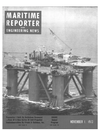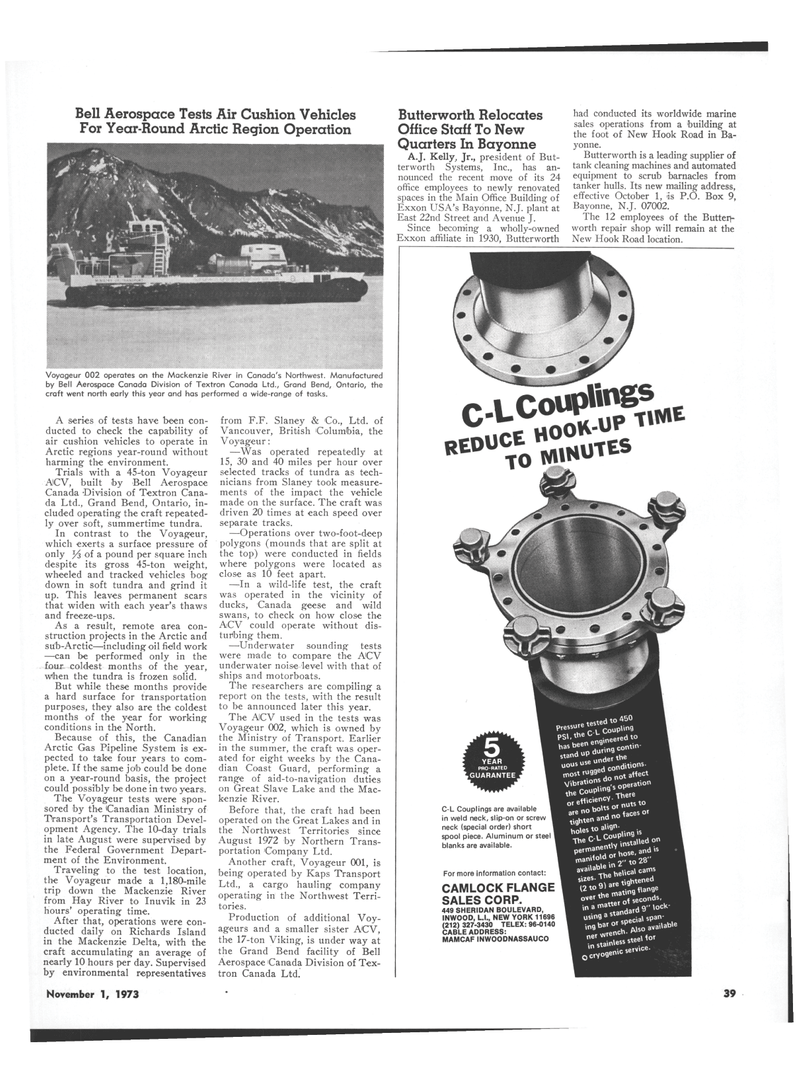
Page 33: of Maritime Reporter Magazine (November 1973)
Read this page in Pdf, Flash or Html5 edition of November 1973 Maritime Reporter Magazine
Bell Aerospace Tests Air Cushion Vehicles
For Year-Round Arctic Region Operation
Butterworth Relocates
Office Staff To New
Quarters In Bayonne
A.J. Kelly, Jr., president of But- terworth Systems, Inc., has an- nounced the recent move of its 24 office employees to newly renovated spaces in the Main Office Building of
Exxon USA's Bayonne, N.J. plant at
East 22nd Street and Avenue J.
Since becoming a wholly-owned
Exxon affiliate in 1930, Butterworth had conduoted its worldwide marine sales operations from a building at the foot of New Hook Road in Ba- yonne.
Butterworth is a leading supplier of tank cleaning machines and automated equipment to scrub barnacles from tanker hulls. Its new mailing address, effective October 1, is P.O. Box 9,
Bayonne, N.J. 07002.
The 12 employees of the Butterv worth repair shop will remain at the
New Hook Road location.
Voyageur 002 operates on the Mackenzie River in Canada's Northwest. Manufactured by Bell Aerospace Canada Division of Textron Canada Ltd., Grand Bend, Ontario, the craft went north early this year and has performed a wide-range of tasks.
A series of tests have been con- ducted to check the capability of air cushion vehicles to operate in
Arctic regions year-round without harming the environment.
Trials with a 45-ton Voyageur
ACV, built by Bell Aerospace
Canada -Division of Textron Cana- da Ltd., Grand Bend, Ontario, in- cluded operating the craft repeated- ly over soft, summertime tundra.
In contrast to the Voyageur, which exerts a surface pressure of only Yz of a pound per square inch despite its gross 45-ton weight, wheeled and tracked vehicles bog down in soft tundra and grind it up. This leaves permanent scars that widen with each year's thaws and freeze-ups.
As a result, remote area con- struction projects in the Arctic and sub-Arctic—including oil field work —can be performed only in the four coldest months of the year, when the tundra is frozen solid.
But while these months provide a hard surface for transportation purposes, they also are the coldest months of the year for working conditions in the North.
Because of this, the Canadian
Arctic Gas Pipeline System is ex- pected to take four years to com- plete. If the same jdb could be done on a year-round basis, the project could possibly be done in two years.
The Voyageur tests were spon- sored by the Canadian Ministry of
Transport's Transportation Devel- opment Agency. The 10-day trials in late August were supervised by the Federal Government Depart- ment of the Environment.
Traveling to the test location, the Voyageur made a 1,180-mile trip down the Mackenzie River from Hay River to Inuvik in 23 hours' operating time.
After that, operations were con- ducted daily on Richards Island in the Mackenzie Delta, with the craft accumulating an average of nearly 10 hours per day. Supervised by environmental representatives from F.F. Slaney & Co., Ltd. of
Vancouver, British Columbia, the
Voyageur: —Was operated repeatedly at 15, 30 and 40 miles per hour over selected tracks of tundra as tech- nicians from Slaney took measure- ments of the impact the vehicle made on the surface. The craft was driven 20 times at each speed over separate tracks. —Operations over two-foot-deep polygons (mounds that are split at the top) were conducted in fields where polygons were located as close as 10 feet apart. —In a wild-life test, the craft was operated in the vicinity of ducks, Canada geese and wild swans, to check on how close the
ACV could operate without dis- turbing them. —Underwater sounding tests were made to compare the ACV underwater noise level with that of ships and motorboats.
The researchers are compiling a report on the tests, with the result to be announced later this year.
The ACV used in the tests was
Voyageur 002, which is owned by the Ministry of Transport. Earlier in the summer, the craft was oper- ated for eight weeks by the Cana- dian Coast Guard, performing a range of aid-to-navigation duties on Great Slave Lake and the Mac- kenzie River.
Before that, the craft had been operated on the Great Lakes and in the Northwest Territories since
August 1972 by Northern Trans- portation Company Ltd.
Another craft, Voyageur 001, is being operated by Kaps Transport
Ltd., a cargo hauling company operating in the Northwest Terri- tories.
Production of additional Voy- ageurs and a smaller sister ACV, the 17-ton Viking, is under way at the Grand Bend facility of Bell
Aerospace Canada Division of Tex- tron Canada Ltd.
REDU ™ WW"®
C-L Couplings are available in weld neck, slip-on or screw neck (special order) short spool piece. Aluminum or steel1 blanks are available.
For more information contact:
CAMLOCK FLANGE
SALES CORP. 449 SHERIDAN BOULEVARD,
INWOOD, L.I., NEW YORK 11696 (212) 327-3430 TELEX: 96-0140
CABLE ADDRESS:
MAMCAF INWOODNASSAUCO
November 1, 1973 39

 32
32

 34
34
